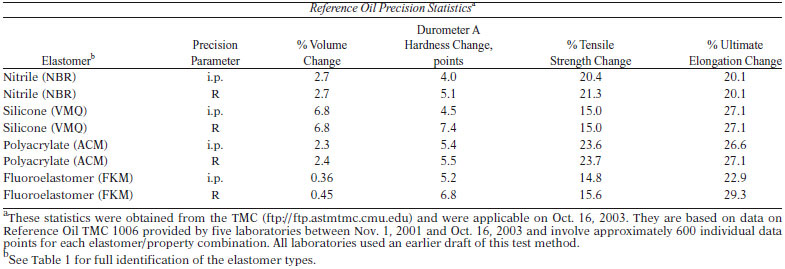EXPLANATION
Some engine oil formulations have been shown to lack compatibility with certain elastomers used for seals in automotive engines. These deleterious effects on the elastomer are greatest with new engine oils and when the exposure is at elevated temperatures. This test method covers quantitative procedures for the evaluation of the compatibility of automotive engine oils with four reference elastomers typical of those used in the sealing materials in contact with these oils. Compatibility is evaluated by determining the changes in volume, Durometer A hardness and tensile properties when the elastomer specimens are immersed in the oil for a specified time and temperature. Effective sealing action requires that the physical properties of elastomers used for any seal have a high level of resistance to the liquid or oil in which they are immersed. When such a high level of resistance exists, the elastomer is said to be compatible with the liquid or oil.
This test method provides a preliminary or first order evaluation of oil/elastometer compatibility only. Because seals may be subjected to static or dynamic loads, or both, and they may operate over a range of conditions, a complete evaluation of the potential sealing performance of any elastomer/oil combination in any service condition usually requires tests additional to those described in this test method. The four reference elastomer formulations specified in this test method were chosen to be representative of those used in heavy-duty diesel engines. The procedures described in this test method can, however, be used to evaluate the compatibility of automotive engine oils with different elastomer types/formulations or different durations and temperatures to those employed in this test method.
This test method requires that non-reference oil(s) be tested in parallel with a reference oil, TMC 1006, known to be aggressive for some parameters under service conditions. This relative compatibility permits decisions on the anticipated or predicted performance of the non-reference oil in service. Elastomer materials can show significant variation in physical properties, not only from batch-to-batch but also within a sheet and from sheet-to-sheet. Results obtained with the reference oil are submitted by the test laboratories to the TMC to allow it to update continually the total and within-laboratory standard deviation estimates. These estimates, therefore, incorporate effects of variations in the properties of the reference elastomers on the test variability.
TEST SUMMARY
Measurements of initial volume, hardness (Durometer A) and tensile properties (ultimate elongation and tensile strength) are made on specimens of specified dimensions cut from sheets of reference elastomers. These elastomer specimens are immersed in both non-reference oil(s) and a reference oil and aged for 336 h at specified temperatures. The effects of the test oil on the elastomers are determined by measuring the changes in volume, hardness, and tensile properties resulting from the immersion in the oil.
TEST PRECISION
See table - for precision obtainable by this test method. No estimate of the bias for this procedure is possible because the performance results for an oil are determined only under the specific conditions of the test and no absolute standard exists.




